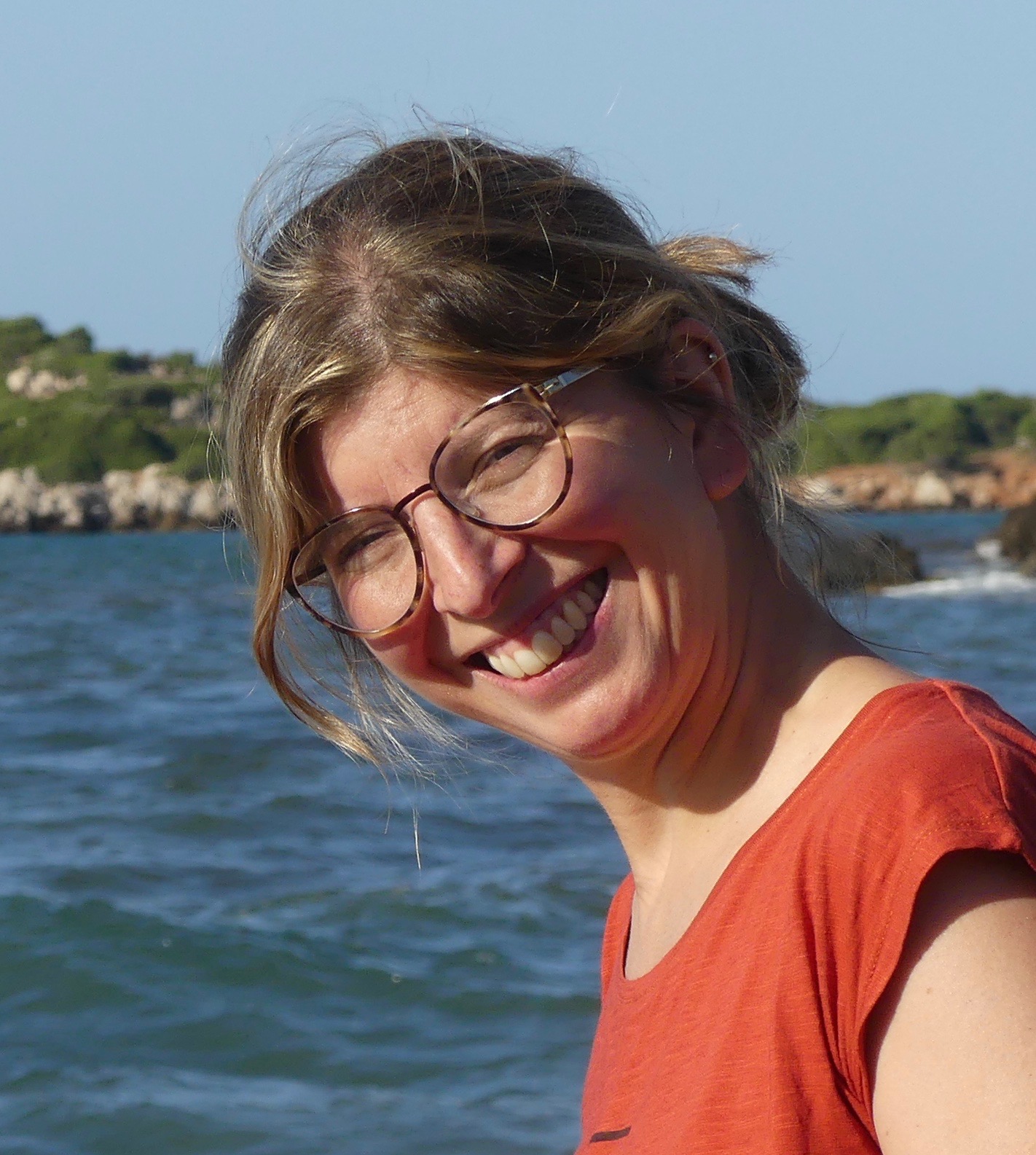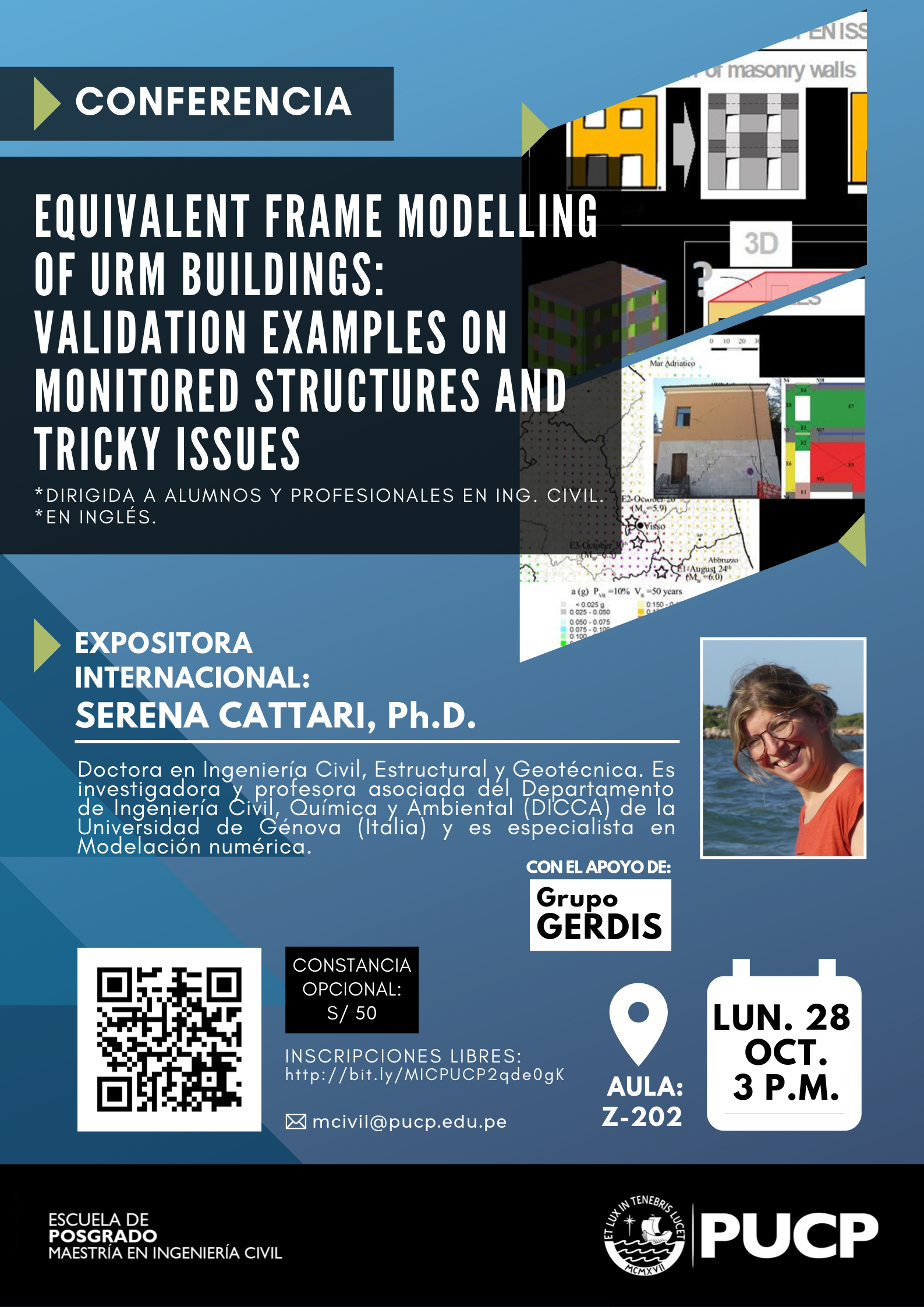Infórmate sobre la próxima visita de Serena Cattari, Ph.D. (octubre)
 La Maestría en Ingeniería Civil de la PUCP comunica que en el mes de octubre nos visitará Serena Cattari, Ph.D., profesora asociada e investigadora de la Universidad de Génova (Italia). La invitada brindará asesoría a alumnos de pregrado y posgrado; además, ofrecerá una conferencia abierta al público y una clase magistral para alumnos de la PUCP. La visita se realizará gracias a las gestiones de los profesores Nicola Tarque y César Chácara, y con el apoyo del GRUPO GERDIS.
La Maestría en Ingeniería Civil de la PUCP comunica que en el mes de octubre nos visitará Serena Cattari, Ph.D., profesora asociada e investigadora de la Universidad de Génova (Italia). La invitada brindará asesoría a alumnos de pregrado y posgrado; además, ofrecerá una conferencia abierta al público y una clase magistral para alumnos de la PUCP. La visita se realizará gracias a las gestiones de los profesores Nicola Tarque y César Chácara, y con el apoyo del GRUPO GERDIS.
Conferencia| Equivalent frame modelling of urm buildings: validation examples on monitored structures and tricky issues
*Dirigida a ingenieros civiles y profesionales afines al tema.
*En inglés.
In the specific field of the seismic assessment existing masonry buildings, in the last decades the Equivalent Frame (EF) Approach has met great success not only at research level but also for practice engineering aims due to its simplicity of implementation and to its computational efficiency, in particular for nonlinear analyses. Its use implies a proper awareness on the various modelling hypotheses which is based on and the various possibilities the adopted software offers to effectively describe the variety of structural details and configurations that characterize existing buildings. The lecture will offer an overview on such issues, such as: (i) the definition of the structural elements geometry, which in the EF models has to be defined “a priori”; (ii) the role of diaphragms; (iii) how can be managed the connection between the orthogonal walls (flange effect). Finally, its reliability is validated thanks: to the comparison with more refined modelling approaches; to the numerical simulation of the actual seismic response of some complex buildings permanently monitored by the Italian structural seismic monitoring network (Dolce et al, 2017 DOI:10.1007/s10518-015-9738-x). The latter is particularly interesting since the buildings have been hit by the 2016-2017 Central Italy earthquake and recordings of the real response are available.
Fecha y hora: lunes 28 de octubre a las 3 p.m.
Lugar: Z202 – Pabellón Z (ver plano: http://descubre.pucp.edu.pe/poi/lug027)
Ingreso libre, previo registro (paso 1): http://bit.ly/MICPUCP2qde0gK
Constancias opcionales: S/ 50 (paso 2 y 3)
Descarga el afiche aquí: Afiche evento 28.10.19

Clase magistral| Fragility curves for building stocks: derivation from macroseismic and mechanical-based models and calibration through empirical data
*Dirigida a alumnos de pregrado PUCP y alumnos de la Maestría en Ingeniería Civil PUCP
*En inglés.
In the framework of seismic risk analyses at large scale, among the available methods for the vulnerability assessment, the empirical and mechanical-based models represent some of most widely used options. On the one hand, empirical models benefit of a direct correlation to the actual seismic behaviour of buildings and they are easy to handle also on huge stocks of buildings; on the other, mechanical-based models are able to explicitly distinguishing the influence of various structural and mechanical parameters on the seismic response. Thus, an integrate use of them can be very fruitful. Within this context, the seminar focuses on the derivation procedure of fragility curves from a macroseismic vulnerability model and a mechanical-based model and their application to unreinforced masonry (URM) building stocks. The macroseismic model starts from the original proposal of Lagomarsino and Giovinazzi (2006) and has further developed in recent years through a robust calibration on the observed damage collected after many earthquakes in Italy, available from the database Da.D.O. developed by the Italian Department of Civil Protection (DPC) (Dolce et al. 2017). The model has been recently applied in the context of ReLUIS project ( funded by the DPC) to support the development of Italian Risk Maps (Dolce et al. 2019). The mechanical-based model has been proposed in Lagomarsino and Cattari (2014): its use is discussed to derive fragility curves with the main advantage to directly employ the seismic input in the spectral form and quantify the different sources of dispersion (coming from building capacity, seismic input, definition of damage levels). In the class, the potential and drawbacks of both methods are discussed showing also some example on stocks representative of URM Italian residential buildings.
Fecha y hora: martes 29 de octubre de 6 a 8 p.m.
Lugar: por confirmar
Ingreso libre, previo registro: enviar un correo a mcivil@pucp.edu.pe con el asunto“INSCRIPCIÓN – FRAGILITY CURVES FOR BUILDING STOCKS”
Se entregarán constancias a los asistentes.
Descarga el afiche aquí: Afiche evento 29.10.19

Breve sumilla de la expositora: Serena Cattari, Ph.D
Doctora en Ingeniería Civil, Estructural y Geotécnica. Es investigadora y profesora asociada del Departamento de Ingeniería Civil, Química y Ambiental (DICCA) de la Universidad de Génova (Italia) y es especialista en Modelación numérica.
Estoy interesado
Hola, si eres estudiante PUCP puedes participar en la clase de hoy:
“FRAGILITY CURVES FOR BUILDING STOCKS: DERIVATION FROM MACROSEISMIC AND MECHANICAL-BASED MODELS AND CALIBRATION THROUGH EMPIRICAL DATA”
*Dirigida a alumnos de pregrado PUCP y de la Maestría en Ingeniería Civil PUCP.
*Se verificarán los códigos de alumnos.
*En inglés